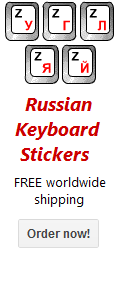| FR | About us | Home | User agreement | Link to us |
Matryoshka – The Russian Nesting Doll
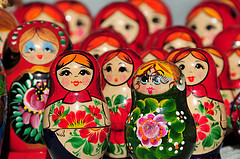
It's hard to find a symbol of Russia more popular than the traditional Russian nesting doll. These decorated wooden dolls "with a secret" are also called matryoshka dolls or babushka dolls. They are recognized even in the countries thousand miles away from Russia. Taking a Russian nesting doll back home is a must among tourists from Europe and the United States alike. The lovers of exotics collect matryoshkas in Australia and South Africa. The simplicity and originality of matryoshka dolls attract the fans of Russian folk art from around the world. Bright and picturesque Russian nesting dolls decorate the fireplaces and bookshelves in the homes of thousands of Russians.
The history of Russian nesting dolls
Some historians of Russian life argue that matryoshka dolls originated from Japanese traditional dolls. However it's known that Russian masters would make hollow detachable Easter eggs from the wood long before the first nesting doll was made. The first Russian nesting doll set appeared in Moscow in 1890's. It was carved by Vasily Zvyozdochkin from a design by a folk crafts painter Sergey Malyutin. The doll set consisted of eight dolls of decreasing sizes placed one inside the other. All eight dolls depicted children -- the outermost was a girl holding a rooster, six inner dolls were girls, the fifth doll was a boy, and the innermost was a baby.
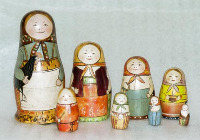
Despite the fact that first matryoshka dolls were intended for children, their price was so high that only adults could afford to buy them on special occasions. Matryoshka dolls were often given as a present to young women from their beloved ones. In 1900, the dolls earned a bronze medal at the World Exhibition in Paris. Soon after, Russian nesting dolls became wildly popular. The toys were being produced in several well-known manufacturing centers, the most famous of them being Sergiev Posad and Semenov. In the early twentieth century, Russian nesting dolls were being exported abroad in large quantities. The popularity of the dolls even gave rise to a few companies in Germany which produced counterfeit nesting dolls and sold them as Russian toys.
How are Russian nesting dolls made?
It takes a lot of skill to make a Russian nesting doll set. Traditionally, matryoshka dolls were made from linden or birch and their production would involve the participation of the whole family. The dolls of the cylindrical form were painted in different ways: it could be a peasant girl dressed in a sarafan and a headscarf, a man or a child. Matryoshka dolls are often painted holding a basket of berries, bread, or a bunch of flowers in their hands.
The production process would begin with the smallest, innermost doll that was lathed from a single piece of wood and wouldn't separate as opposed to the larger figures. The number of nested dolls in a set could vary from two to sixty however a classic set normally included five nested figures. The carved dolls were covered with special glue to fill the cracks and reduce the roughness, after which the dolls were painted to follow a particular theme.
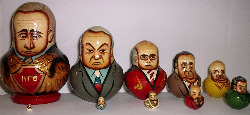
Photo by Brandt Luke Zorn CC-SA2.0
Today, the same process is used in for hand-made nesting dolls some Russian villages. The nesting dolls can be painted to follow the traditional theme or any other style, including fairy tales characters, animals, famous political leaders, historical figures, musicians and popular movie stars.
A fancy set like that might make a good gift. When in Russia, you can purchase Russian nesting dolls at most places where souvenirs are sold. In Moscow, Izmaylovo Market is an excellent souvenir venue where hundreds of vendors offer myriads of gifts for sale. It's a good idea to reserve a hotel in Moscow and dedicate a full day to shopping at the market.
Russian nesting dolls: Record-breakers
In 1913, a factory in the city of Semyonov produced a matryoshka dolls set that consisted of 48 figures and was painted in traditional red and yellow colors.
In the meantime, the biggest Russian dolls set was presented at the exhibition in Japan in 1970. Russian masters from Semenov showcased a matryoshka set that included seventy-two figures. The production of such matryoshkas requires exceptional skills and talent, so their mass production is not possible.
Got questions?
Ask them in the Russian Questions and Answers — a place for students, teachers and native Russian speakers to discuss Russian grammar, vocabulary, pronunciation, and other aspects of the Russian language.
Copyright 2001-2024 MasterRussian.com | Privacy Policy | Contact Us
 Russian Lessons
Russian Lessons
- Russian alphabet
- Names of letters
- Russian Q&A new
- Pronunciation: Cons.
- Pronunciation: Vowels
- Noun Gender/Number
- Cases of Nouns
- Russian Greetings
- Personal Pronouns
- Learning Russian
- 1000 Common Words
- 500 Russian Verbs
- Top Russian Nouns
- » All lessons
- » Guest lessons
 Browse Topics
Browse Topics
- Start learning Russian
- Forum
- Bookstore
- Dictionaries
- Russian - basic
- Russian - adv
- Pronunciation
- Russian Blog new
- Reading
- Test & quizzes
- Translation
- Verbs
- Verb Conjugations
- Russian numbers
- Russian Tests new
- Vocabulary
- Writing
- Folk music
- Fun stuff
- Leo Tolstoy
- Learner's lore
- Literature
- Personal blogs
- Picture Dictionary new
- Proverbs
- Publications
- Radio & TV
- Russian culture
- Schools in Russia
- Russian Words
- Russian names
- Software
- Russian Words iPhone

Search MasterRussian

English » Russian dictionary

WORD OF THE DAY
![]() RSS
|
iGoogle
|
My Yahoo!
RSS
|
iGoogle
|
My Yahoo!
Meaning: to love, like, need
Pronunciation: [lyoo-BEET']
Learn Russian words more... »
TODAY'S STREET SIGN
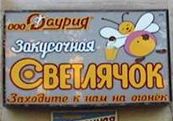
Russian: Закусочная ''Светлячок''
English: Firefly snack-bar
FOLLOW US ON TWITTER

MasterRussian on Twitter


